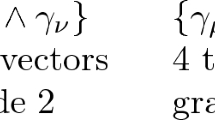Abstract
The gauge coupling constants in the electroweak standard model can be written as mass ratios, e.g. the coupling constant for isospin interactions \(g^2_2=2\frac{m^2_{\rm W}}{m^2}\sim 2(\frac{80}{169})^2\sim\frac{1}{2.3}\) with the mass of the charged weak boson and the mass parameter characterizing the ground state degeneracy. A theory is given which relates the two masses in such a ratio to invariants which characterize the representations of a noncompact nonabelian group with real rank 2. The two noncompact abelian subgroups are operations for time and for a hyperbolic position space in a model for spacetime, homogeneous under dilation and Lorentz group action. The representations of the spacetime model embed the bound state representations of hyperbolic position space as seen in the nonrelativistic hydrogen atom. Interactions like Coulomb or Yukawa interactions are described by Lie algebra representation coefficients. A quantitative determination of the ratio of the invariants for position- and time-related operations, determined by the spacetime representation, gives the right order of magnitude for the gauge coupling constants.
Similar content being viewed by others
References
Bargmann, V. (1947). Irreducible representations of the Lorentz group. Annals of Mathematics 48, 568–640.
Behnke, H. and Sommer, F. (1962). Theorie Der Analytischen Funktionen Einer Komplexen Veränderlichen, Springer-Verlag, Berlin, Göttingen, Heidelberg.
Bochner, S. (1933). Monotone Funktionen, Stieltjessche intergrale und harmonische analyse, Math. Annalen 108, 378–410.
Boerner, H. (1955). Darstellungen von Gruppen, Springer, Berlin, Göttingen, Heidelberg.
Bourbaki, N. (1989). Lie Groups and Lie Algebras, Springer, Berlin, Heidelberg, New York, London, Paris, Tokyo, Chapters 1–3.
Fock, V. (1935). Zur Theorie des Wasserstoffatoms. Zeitschrift für Physik 98, 145–154.
Folland, G. B. (1995). A Course in Abstract Harmonic Analysis, CRC Press, Boca Raton, Ann Arbor, London, Tokyo.
Fulton, W. and Harris, J. (1991). Representation Theory, Springer-Verlag, Berlin.
Gel'fand, I. M., Graev, M. I., and Vilenkin, N. Y. (1962). Generalized Functions V (Integral Geometry and Representation Theory) (English translation 1966), Academic Press, New York, London.
Gel'fand, I. M. and Neumark, M. A. (1950). Unitäre Darstellungen der klassischen Gruppen (German Translation 1957), Akademie Verlag, Berlin.
Gel'fand, I. M. and Raikov, D. A. (1942). Irreducible unitary representations of locally bicompact groups, Mat. Sbornik 13(55), 301–316.
Gel'fand, I. M. and Shilov, G. E. (1958). Generalized Functions I (Properties and Operations) (English translation 1963), Academic Press, New York, London.
Heisenberg, W. (1967). Einführung in die einheitliche Feldtheorie der Elementarteilchen, Hirzel, Stuttgart.
Helgason, S. (1984). Groups and Geometric Analysis, Academic Press, New York, London, Sydney, Tokyo, Toronto.
Hucks, J. (1991). Global structure of the standard model, anomalies and charge quantization. Physical Review D 43, 2709–2717.
Kirillov, A. A. (1976). Elements of the Theory of Representations, Springer-Verlag, Berlin, Heidelberg, New York.
Knapp, A. (1986). Representation Theory of Semisimple Groups, Princeton University Press, Princeton.
Mackey, G. W. (1951). On induced representations of groups. American Journal of Mathematics 73, 576–592.
Neumark, M. A. (1958, German Translation 1963). Lineare Darstellungen der Lorentzgruppe, VEB Deutscher Verlag der Wissenschaften, Berlin.
Peter, F. and Weyl, H. (1927). Die Vollständigkeit der primitiven Darstellungen einer geschlossenen kontinuierlichen Gruppe, Math. Annalen 97, 737–755.
Saller, H. (1989). On the nondecomposable time representations in quantum theories. Nuovo Cimento 104B, 291–337.
Saller, H. (1992). On the isospin–hypercharge connection. Nuovo Cimento 105A, 1745–1758.
Saller, H. (1997a). Analysis of time–space translations in quantum fields. International Journal of Theoretical Physics 36, 1033–1071.
Saller, H. (1997b). Realizations of causal manifolds by quantum fields. International Journal of Theoretical Physics 36, 2783–2826.
Saller, H. (1998a). Central correlations of hypercharge, isospin, colour and chirality in the standard model. Nuovo Cimento 111A, 1375–1392.
Saller, H. (1998b). External–internal group quotient structure for the standard model in analogy to general relativity. International Journal of Theoretical Physics 37, 2333–2362.
Saller, H. (1999). Representations of spacetime as unitary operation classes; or Against the monoculture of particle fields. International Journal of Theoretical Physics 38, 1697–1733.
Saller, H. (2001a). Residual representations of spacetime. International Journal of Theoretical Physics 40, 1209–1248. hep-th/0010057.
Saller, H. (2001b). Symmetry reduction from interactions to particles. International Journal of Theoretical Physics 40, 1151–1172, hepth/0011265.
Saller, H. (2003). Matter as spectrum of spacetime representations, hepth/0304034.
Saller, H. (2004). The basic physical Lie operations, hep-th/0410147.
Saller, H. (2005). Hilbert spaces for stable and unstable particles, hep-th/0501074.
Schur, I. (1905). Neue Begründung der Gruppencharaktere, Sitzungsber. Preuss. Akad., 406.
Sherman, T. O. (1975). Fourier analysis on the sphere. Transactions of the American Mathematical Society 209, 1–31.
Strichartz, R. S. (1973). Harmonic analysis on hyperboloids. Journal of Functional Analysis 12, 341–383.
Treves, F. (1967). Topological Vector Spaces, Distributions and Kernels, Academic Press, New York, London.
Vilenkin, N. J. and Klimyk, A. U. (1991). Representations of Lie Groups and Special Functions, Kluwer Academic Publishers, Dordrecht, Boston, London.
Wigner, E. P. (1939). On unitary representations of the inhomogeneous Lorentz group. Annals of Mathematics 40, 149–204.
Weinberg, S. (1967). A model of leptons. Physical Review Letters 18, 507.
Author information
Authors and Affiliations
Corresponding author
Rights and permissions
About this article
Cite this article
Saller, H. Gauge Coupling Constants as Residues of Spacetime Representations. Int J Theor Phys 45, 276–342 (2006). https://doi.org/10.1007/s10773-005-9021-z
Received:
Accepted:
Published:
Issue Date:
DOI: https://doi.org/10.1007/s10773-005-9021-z



